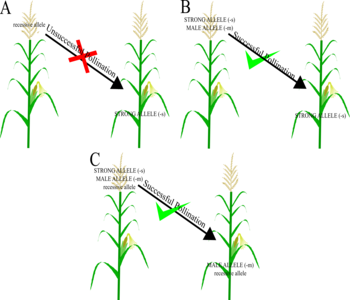Genomic mapping of the modifiers of teosinte crossing barrier 1 (Tcb1)

Short Summary:
- Tcb1 is one of roughly 10 cross-incompatibility systems in maize.
- With QTL mapping we found 2 significant QTL that explained 16% and 17% of the phenotypic variation.
- Markers could be developed to introgress these loci into breeding programs.
Abstract
Pollen cross-contamination has been a major problem for maize breeders. Mechanical methods applied to avoid cross-contamination are largely ineffective and time-consuming. Cross incompatibility barriers are genetic factors involved in maize fertilization that can be used as an effective method to prevent pollen cross-contamination. Teosinte crossing barrier 1 (Tcb1) is a cross-incompatibility system in which silks possessing dominant Tcb1-s reject pollen possessing the recessive allele (tcb1). However, successful fertilization occurs when Tcb1-s pollen falls upon tcb1 silks or under self-fertilization of Tcb1-s pollen on Tcb1-s silks. Previous studies have shown that the efficacy of dominant Tcb1-s was reduced when repeatedly backcrossing with maize inbred lines suggesting the presence of modifiers to Tcb1-s. To find those modifiers, we conducted a QTL mapping experiment using the Intermated B73 x Mo17 (IBM) recombinant inbred lines (RILs) for two consecutive years. Two significant and stable QTL were identified on chromosomes 4L and 5S explained 16% and 17.6% of the total phenotypic variation (R2), and both had negative additive effects. Further investigation of these QTL regions identified twelve candidate genes that could modify Tcb1-s activity. The introgression of the Tcb1-s genetic system, and its appropriate modifying factors, could be a novel and reliable solution for cultivar isolation in maize breeding.
This paper is available on bioRxiv ( https://doi.org/10.1101/2022.07.18.500501)